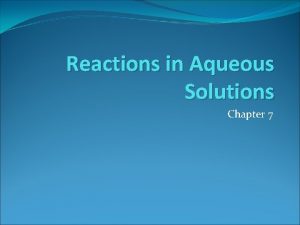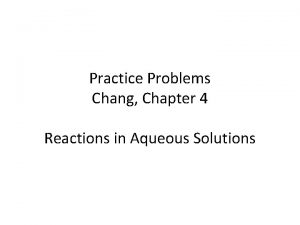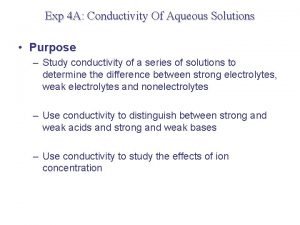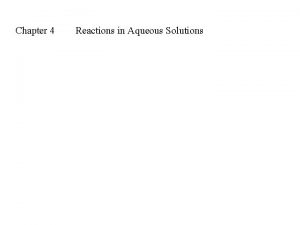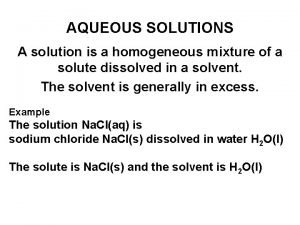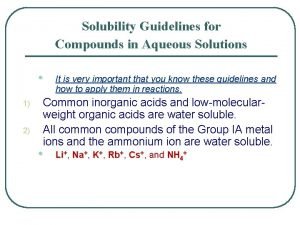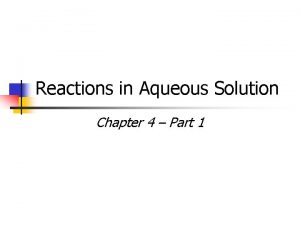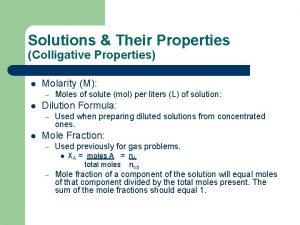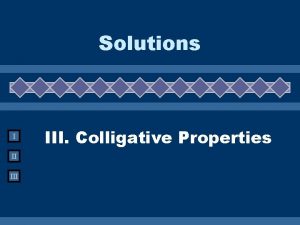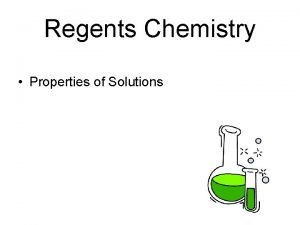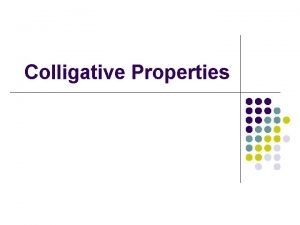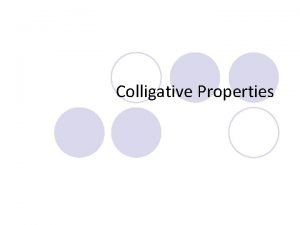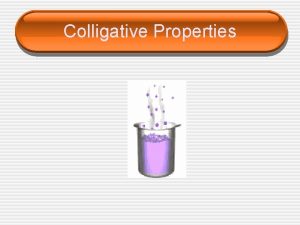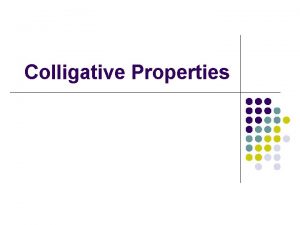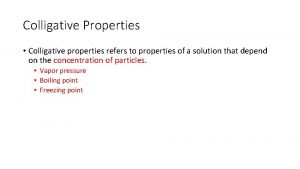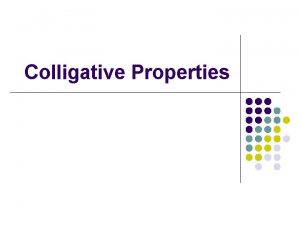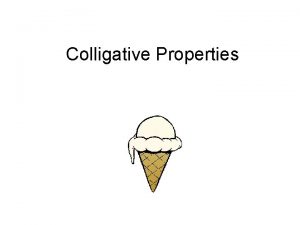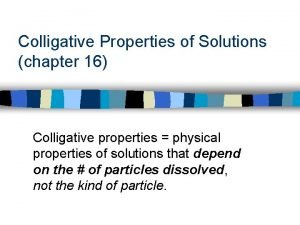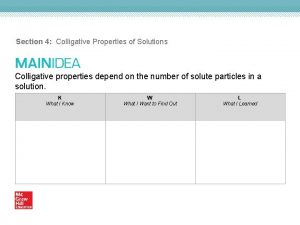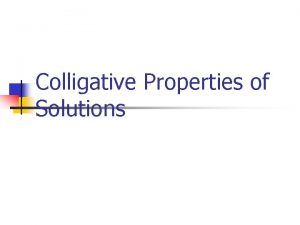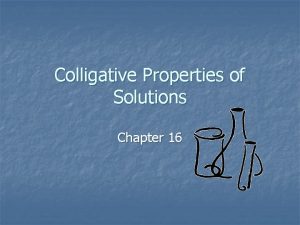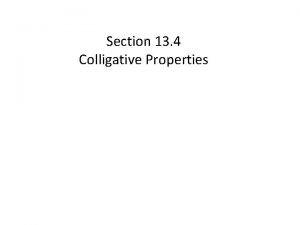Aqueous Solutions Colligative Properties of Solutions Colligative Properties



























- Slides: 27

Aqueous Solutions Colligative Properties of Solutions

Colligative Properties of Solutions Objectives List four colligative properties, and explain why they are classified as colligative properties Calculate freezing-point depression, boiling-point elevation, and solution molality of nonelectrolyte solutions Calculate the expected changes in freezing point and boiling point of an electrolyte solution Discuss causes of the differences between expected and experimentally observed colligative properties of electrolyte solutions

Colligative Properties of Solutions Colligative Properties that depend on the concentration of solute particles but not on their identity are called colligative properties Vapor-Pressure Lowering Freezing-Point Depression Boiling-Point Elevation Osmotic Pressure

Colligative Properties of Solutions Vapor-Pressure Lowering A nonvolatile substance is one that has little tendency to become a gas under existing conditions The boiling point and freezing point of a solution differ from those of the pure solvent A nonvolatile solute raises the boiling point and lowers the freezing point

Colligative Properties of Solutions Vapor-Pressure Lowering

Colligative Properties of Solutions Vapor-Pressure Lowering

Colligative Properties of Solutions Freezing-Point Depression The freezing-point depression, ∆tf , is the difference between the freezing points of the pure solvent and a solution of a nonelectrolyte in that solvent, and it is directly proportional to the molal concentration of the solution. The molal freezing-point constant (Kf ) is the freezingpoint depression of the solvent in a 1 -molal solution of a nonvolatile, nonelectrolyte solute ∆tf = Kfm Freezing Point (solution) = Freezing Point (solvent) + ∆tf

Colligative Properties of Solutions Freezing-Point Depression

Colligative Properties of Solutions Freezing-Point Depression Sample Problem What is the freezing-point depression of water in a solution of 17. 1 g of sucrose, C 12 H 22 O 11, in 200. g of water? What is the actual freezing point of the solution?

Colligative Properties of Solutions Freezing-Point Depression Sample Problem Solution Given: solute mass and chemical formula = 17. 1 g C 12 H 22 O 11 solvent mass and identity = 200. g water Unknown: a. freezing-point depression b. freezing point of the solution

Colligative Properties of Solutions Freezing-Point Depression Sample Problem Solution ∆tf = Kfm f. p. solution = f. p. solvent + ∆tf

Colligative Properties of Solutions Freezing-Point Depression Sample Problem Solution

Colligative Properties of Solutions Freezing-Point Depression Sample Problem Solution a. ∆tf = Kfm ∆tf = 0. 250 m × (− 1. 86°C/m) = − 0. 465°C b. f. p. solution = f. p. solvent + ∆tf f. p. solution = 0. 000°C + (− 0. 465°C) = − 0. 465°C

Colligative Properties of Solutions Boiling-Point Elevation The boiling-point elevation, ∆tb, is the difference between the boiling points of the pure solvent and a nonelectrolyte solution of that solvent, and it is directly proportional to the molal concentration of the solution. The molal boiling-point constant (Kb) is the boiling-point elevation of the solvent in a 1 -molal solution of a nonvolatile, nonelectrolyte solute. ∆tb = Kbm Boiling Point (solution) = Boiling Point (solvent) + ∆tb

Colligative Properties of Solutions Boiling-Point Elevation Sample Problem What is the boiling-point elevation of a solution made from 20. 1 g of a nonelectrolyte solute and 400. 0 g of water? The molar mass of the solute is 62. 0 g.

Colligative Properties of Solutions Boiling-Point Elevation Sample Problem Solution Given: solute mass = 20. 1 g solute molar mass = 62. 0 g solvent mass and identity = 400. 0 g of water Unknown: boiling-point elevation ∆tb = Kbm

Colligative Properties of Solutions Boiling-Point Elevation Sample Problem Solution ∆tb = 0. 51°C/m × 0. 810 m = 0. 41°C

Colligative Properties of Solutions Osmotic Pressure A semipermeable membrane allows the passage of some particles while blocking the passage of others. The movement of solvent through a semipermeable membrane from the side of lower solute concentration to the side of higher solute concentration is osmosis Osmotic pressure is the external pressure that must be applied to stop osmosis

Colligative Properties of Solutions Osmotic Pressure

Colligative Properties of Solutions Electrolytes and Colligative Properties Electrolytes depress the freezing point and elevate the boiling point of a solvent more than expected. Electrolytes produce more than 1 mol of solute particles for each mole of compound dissolved mol of solute particles 1 2 3

Colligative Properties of Solutions Electrolytes and Colligative Properties Colligative properties depend on the total concentration of solute particles. The changes in colligative properties caused by electrolytes will be proportional to the total molality of all dissolved particles, not to formula units For the same molal concentrations of sucrose and sodium chloride, you would expect the effect on colligative properties to be twice as large for sodium chloride as for sucrose

Colligative Properties of Solutions Electrolytes and Colligative Properties Sample Problem What is the expected change in the freezing point of water in a solution of 62. 5 g of barium nitrate, Ba(NO 3)2, in 1. 00 kg of water?

Colligative Properties of Solutions Electrolytes and Colligative Properties Sample Problem Solution Given: solute mass and formula = 62. 5 g Ba(NO 3)2 solvent mass and identity = 1. 00 kg water ∆tf = Kfm Unknown: expected freezing-point depression

Colligative Properties of Solutions Electrolytes and Colligative Properties Sample Problem Solution

Colligative Properties of Solutions Electrolytes and Colligative Properties Sample Problem Solution Each formula unit of barium nitrate yields three ions in solution

Colligative Properties of Solutions Electrolytes and Colligative Properties The actual values of the colligative properties for all strong electrolytes are almost what would be expected based on the number of particles they produce in solution

Colligative Properties of Solutions Electrolytes and Colligative Properties The differences between the expected and calculated values are caused by the attractive forces that exist between dissociated ions in aqueous solution. According to Debye and Hückel a cluster of hydrated ions can act as a single unit rather than as individual ions, causing the effective total concentration to be less than expected. Ions of higher charge have lower effective concentrations than ions with smaller charge
 Freezing point chapter 13
Freezing point chapter 13 General properties of aqueous solutions
General properties of aqueous solutions Which solution
Which solution Reactions in aqueous solutions
Reactions in aqueous solutions Reactions that produce gas
Reactions that produce gas Chapter 13 review ions in aqueous solutions
Chapter 13 review ions in aqueous solutions Aqueous solutions module
Aqueous solutions module Chemical reactions section 3 reactions in aqueous solutions
Chemical reactions section 3 reactions in aqueous solutions Reactions in aqueous solutions practice problems
Reactions in aqueous solutions practice problems Electrical conductivity of aqueous solutions
Electrical conductivity of aqueous solutions Chapter 4 reactions in aqueous solutions
Chapter 4 reactions in aqueous solutions Are all aqueous solutions homogeneous
Are all aqueous solutions homogeneous Are aqueous solutions homogeneous mixtures
Are aqueous solutions homogeneous mixtures Solubility guidelines for aqueous solutions
Solubility guidelines for aqueous solutions Concentrated solution
Concentrated solution Chapter 4 reactions in aqueous solutions worksheet answers
Chapter 4 reactions in aqueous solutions worksheet answers Chapter 4 reactions in aqueous solutions
Chapter 4 reactions in aqueous solutions La molalité
La molalité 4 colligative properties
4 colligative properties Is molarity a colligative property
Is molarity a colligative property Colligative property definition
Colligative property definition Colligative property definition
Colligative property definition Regents
Regents Colligative properties of milk
Colligative properties of milk Non colligative properties examples
Non colligative properties examples Colligative properties worksheet
Colligative properties worksheet Van’t hoff factor
Van’t hoff factor Colligative properties
Colligative properties



